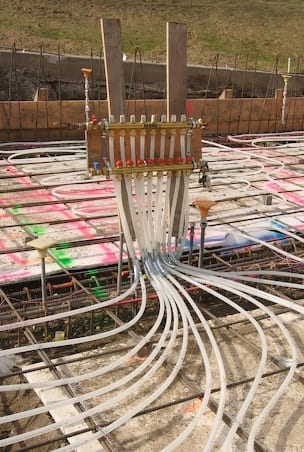Radiant heat has been used since ancient times, perhaps as far back as 4000 BC in Mongolia. The ancient Romans, too, made use of a type of radiant heating known as a hypocaust to heat their houses and public baths. Recent decades have seen more mainstream use of radiant heating in Europe, although it is finally gaining popularity in the United States, especially in new-home construction, where installation is more economical. While European inspectors have far more experience with these systems, American and Canadian inspectors should be prepared to encounter them with increasing frequency.
of a type of radiant heating known as a hypocaust to heat their houses and public baths. Recent decades have seen more mainstream use of radiant heating in Europe, although it is finally gaining popularity in the United States, especially in new-home construction, where installation is more economical. While European inspectors have far more experience with these systems, American and Canadian inspectors should be prepared to encounter them with increasing frequency.
- water (hydronic) radiant heat: This system uses hot water carried by tubing, arranged in a grid, to heat the home.
- electric radiant floors: This system uses electricity carried by cables or floor mats to heat the home.
An installation of a radiant floor heating systems is either wet or dry (not to be confused with the aforementioned distinctions), and the decision to use one or the other is largely based on whether the system will be installed in new or existing construction. These two methods are briefly summarized as follows:
- In a wet installation, the heating panels are installed on the floor, and a thin layer of concrete or gypsum is spread over the installation, sandwiching the cables or tubing between two layers of flooring or concrete. This installation is ideal in new-home construction, where a concrete slab, which has high thermal mass, is used to build the ground floor.
- Radiant floor dry installations are relatively new strategies in which the cables or tubing run in an air space beneath the floor. Tubing is often sandwiched between layers of plywood or beneath the subfloor. Dry heating is more common in retrofits and when the floors in new homes are not poured concrete.
Advantages of Radiant Heating
- efficiency. Radiant heating systems use less energy than convective heating systems where the same fuel is being used. This is due to a number of reasons:
- The thermostat can be set to a lower temperature and still afford the same comfort. Rooms heated by radiance are typically heated uniformly from floor and ceiling, in contrast with forced-air systems, which leave the floors cold. Studies conducted by the American Society of Heating, Refrigeration and Air Conditioning Engineers (ASHRAE) indicate that people can be as comfortable at temperatures 6 to 8 degrees lower with radiant heating than with convective heating that uses air as the primary heat-transfer medium.
- They require no ducts or pipes, which account for heat losses in other systems.
- There is less heat loss through windows because air is not being blown.
- Radiant heaters can be zoned so that energy is only used to heat individual rooms. You can thus more easily direct heat to areas that are more trafficked or chillier, while directing heat away from rooms that see little use.
- Radiant heating systems, unlike forced-air systems, pose little threat of spreading dust, pollen and germs.
- flexible fuel choices. Hydronic systems can be heated with a wide variety of energy sources, such as solar water heaters or gas, wood or oil-fired boilers.
- unobtrusive. Radiant heating systems are not visible in the occupied space, which saves floor space and allows for more decorative freedom.
- quiet and clean. Radiant heating systems are quiet, clean and require little or no maintenance. An oil-fired heating boiler, on the other hand, requires annual maintenance.
- Radiant heaters take a long time to cool. This can be beneficial in several ways:
- The heater can be run at night during off-peak hours when electricity rates are cheaper. It can then be turned off, yet still radiate heat, during peak hours.
- As it takes a long time for radiant heaters to cool down, they will continue to provide heat for hours into a blackout.
Disadvantages of Radiant Heating
- Additional under-slab insulation is required for radiant heating systems mounted on the ceiling.
- limited choice of floor covering. Carpet, due to its properties as a thermal insulator, reduces efficiency of in-floor systems. Wood, too, may not be a good choice because of its tendency to crack or shrink when heated. If wood must be used, it is best to use wood with a low moisture level to avoid shrinking and gaps.
- potentially high utility costs. In some areas, electricity is the most expensive way to provide heat.
- high up-front cost. Due to their complex installation, up-front costs can be prohibitive.
- long warm-up period. Electric systems heat up faster than liquid systems, although both take longer than conventional forced-air systems.
- They can only be used to heat. Separate systems are required to provide cooling, air cleaning and ventilation. A forced-air system, by contrast, can do all of these things.
- Maintenance and repair of pipes may be difficult due to their lack of accessibility.
From Radiant Heating Systems – InterNACHI http://www.nachi.org/radiant-heating-systems.htm#ixzz34XDlAaG9
